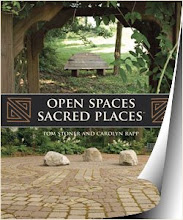Your kitchen is calling. It's
inviting you to engage the magic of transformation by taking the gifts
of the earth and cooking them into meals that nourish the depths of your
being. To make a kitchen for your soul, you don't need an expensive
remodel. You don't need new cabinets or industrial strength appliances.
All you need is to open your senses to the act of preparing food and the
willingness to appreciate the simple miracle being created in the act.
It
only takes a moment to shift your kitchen from a storage room for
snacks into a place of soulful alchemy. Instead of unconsciously
stumbling into your kitchen and grabbing something from the frig,
plopping it on a plate and stuffing it in your mouth, try this. Stop,
look at where you are and sense the possibilities. The stove is offering
fire. The sink is providing water, the refrigerator and cupboards are
filled with earthy bounty from the world's garden. All that's needed is
for you to feel the desire in your belly and allow it to guide you in
creating a meal. As you open the doors of the frig or cabinet to select
the vegetables, grains and other items, savor the colors, shapes and
design of the food. Imagine the fields and orchards they came from and
the natural processes of weather and soil that produced them. As you
slice and combine the ingredients, notice how your participation
transforms the raw materials of nature and sense your consciousness as
an ingredient being blended into the mix. When you place the mixture on
the stove or in the oven, feel the power of fire to release the flavors
from within the food. When the meal is cooked, serve it and eat it with the same attention you put into the preparation. Appreciate the colors and aroma of the food. Enjoy the shapes and materials of the plates and eating utensils. Actually taste what you are tasting. Feel the nourishment of what your are swallowing. Breathe and notice how easy it was to create a kitchen for your soul.
If you do want to remodel your existing kitchen or are planning one for a new home, use the experience I described above as the basis for creating a soulful place to cook. See your kitchen as a place where the elements of fire, water, earth and air interact to produce meals that nourish both body and soul. Choose a range that evokes the experience of primal fire. Select a sink and faucet that honors the fluid, transforming qualities of water. Find cabinets that celebrate the foods you will store in them. Create a kitchen that inspires you to explore creative possibilities, one that says to you, "Let's cook!"
Learn more about creating a home for your soul by clicking here.















